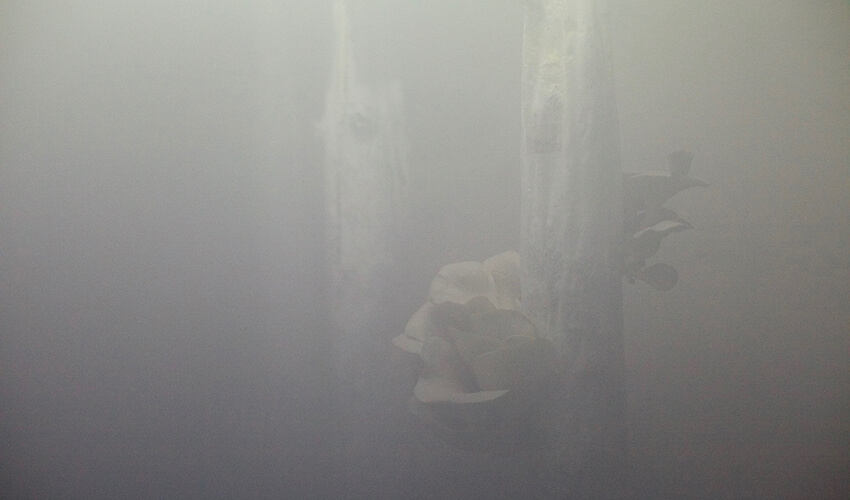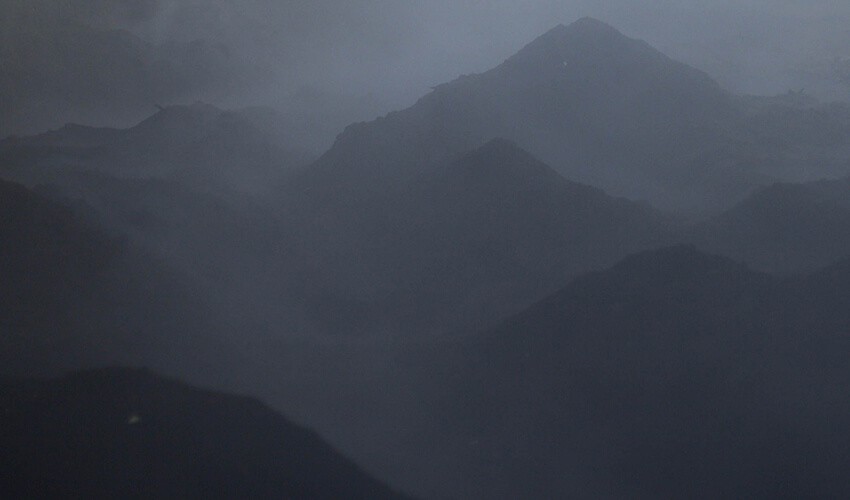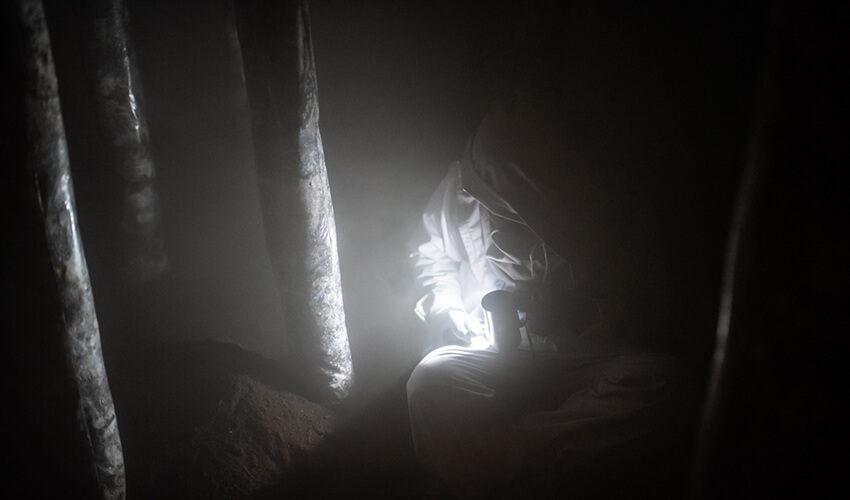Interview by Tina Gorjanc

Annike Flo takes part in one of the expanding new branches of design, which interacts with science and technology in order to make sense of the effects of our current geological age. Viewed as the period during which human activity has been the dominant influence on climate and the environment, Flo’s interest lies in the concept of making the stage and the inner workings of immersive performative projects.
Although her work at the time was exclusively restricted to the production of performance wear, her inclusion in such projects stimulated her fascination with the entanglements of reality and performance, as well as the process of including the audience in the creative work itself.
Her newly-found interest at the time led her to complete an MA in scenography from the Norwegian Theatre Academy in 2018, where she specialised in design for immersive and participatory theatre. Through her practice, Flo started investigating the topic that questions what it means to create in the age of the Anthropocene through sub-themes of agency, our imagined nature-culture divide and our relationship to non-human beings.
By viewing those aspects of the present-day era from a scenographic perspective, she aims to bring the audience into her work through staged spatial events that crossover between reality and performance. Her Masters’ project, Cocreat:e:ures (2018), dives into the currently unbalanced coexistence between the human and other species of organisms by aiming at unpacking further the question: What is an artistic oddkin and what happens when I let another being into my creative process?
The creative output acts as an aesthetic experiment exploring Donna Haraway’s Staying with the trouble and interpreting it as a call to action. The project is set on the premise of the circular economy model through the concept of trans-species co-creation, which reinstitutes fungi as a potential oddkin.
Flo’s interest in and exploration of scenography as a fully operating ecosystem within itself continues to shape her work further. Commissioned by FAEN (Female Artistic Experiments Norway), a new iteration of her Cocreat:e:ures project which will focus on creating a hybrid between a tangible and digital environment. This work will be displayed at Atelier Nord from October until November 2019 and Meta.Morf in 2020, both in Norway.


You are an artist with an interest in art that incorporates science and technology. For those that are not familiar with your practice yet, could you tell us a bit about your background and inspirations? How and when do the interests in these different disciplines come about?
This is a funny one. I’ve actually worked as a costume designer in London for eight years, specialising in immersive theatre, working with companies like Secret Cinema, Immersive Cult, Punch Drunk and various others. The things I was the most interested in were the concept-making and the inner workings of an immersive piece, which I rarely got to touch working in costume.
I’m incredibly fascinated by the entanglements of reality and performance and the process of letting others into a piece of work. To set up the inner workings of something, like an experiment, and then open it up to an audience with their own stories, references and agendas.
So I decided to move to Norway to do an MA in Scenography at The Norwegian Theatre Academy, which allowed me to work with Scenography in a very expanded sense.
This all coincided with my first encounter with the Anthropocene as a concept, which I still feel demands of us a whole new way of thinking and being in the world, and thus also relating to arts. Technology and science are both ways that can connect us and give us deeper knowledge of the world around us (as well as the opposite). This is where my interest lies.
In your work, you imagine a nature-culture divide and relationship to non-human beings from a scenographic perspective. Could you please expand more on this?
Through my work, I attempt to investigate and erase nature-culture divides. The theatre is such a human-centred institution. I find it interesting to investigate the back and forth of how the Anthropocene might change my work as a scenographer and what happens when I interpret the Anthropocene through a scenographic lens.
From my scenographic perspective, I read (aspects of ) the Anthropocene as a spatial event: Humans encroaching, infringing, and violating the spaces of others.
Our touch, sound, light, scent, chemicals and materials permeate the planet. Consequently, I see a new awareness of the other, a decentering of the human and an offering up of space as subversive and defiant acts that scenography can do and facilitate. I’ve written lately that I see my medium as space, and what matters is how and with whom I appropriate it.
Like so many other artists, I’ve been very inspired by Donna Haraway, Anna Tsing and Latour. Because of them, I very much regard scenographies as ecosystems. Both as a concept (what is connected to what and whom, even in a regular blackbox) and in a more literal sense: I am interested in the flakes of skin you drop in the work as an audience member and who eats it and who else they are connected to.
In a project for Female Artistic Experiments Norway (FAEN) curated by Zane Cerpina, I’m (hopefully) working with microbes that we never notice and equipment no longer in use, both living and stored in a disused area of the gallery. I’m interested in this care of noticing and caring, of working with and giving space to who and what is there.
So perhaps a summary is: I relate to scenography as an ecosystem, where various actants influence and shape each other, from which aesthetics and narratives arise.
I am a part of this as a scenographer, whoever I am collaborating with (human/non-human), the audience, the various machines connected to us or the space, the space itself, and then involvement by the myriad of others that I didn’t anticipate would enter that still influence the work in various ways. The work has to remain porous and open to intervention.
About your creative process, does your work generally involves a lot of conceptual development beforehand, or it stems more from an aesthetic need?
My creative process is normally dealing with a question that I am curious about. My overarching question is still How/Do I create in the age of the Anthropocene? Cocreat:e:ures (2018) dealt with the question of what is an artistic (odd)Kin (Haraway).
And what happens when I let another being into my creative process? When working with certain questions, most of the process is the piece. It’s an aesthetic and spatial experiment that the audience is welcomed into. The aesthetics are only allowed to arise from the process.
Right now, I am working on a piece for a small performance festival, and a group of Islands called Steilene outside Oslo. I am fascinated with the processes that make a space into a place for us as humans. I am curious about what happens if creating connections to other species, and perhaps particularly red-listed species, is what informs this process for the audience members arriving at the island.
This work is almost like a little sketch, not lots of concept work, but just the process of doing it with audience participators. I often include guestbooks or other means of audience reflection in my work to catch some of the narratives that arise from it.
I also try to work with other forms of documentation as an integral part of the work: video, stills and sound-catching glimpses of experiences, narratives and processes as the work is running.
Your project Cocreat:e:ures (2018) is an aesthetic experiment and scenography exploring Donna Haraway’s Oddkin and circular economy through trans-species co-creation. Could you tell us a bit more about the intellectual process behind it?
I read Haraway’s Staying with the Trouble is a call to action. Working with her ideas, I knew the scenography had to DO and present, not illustrate, not represent. For cocreat:e: ures I went out to investigate what an artistic oddkin might be. Working through Haraway’s rich imagery as well as investigating biomaterials, I became interested in fungi as a potential oddkin, especially the Oyster Mushroom.
Culturally it challenges us as it functions in radically different ways to how we do as people. For example, you can divide the mycelium up into different colonies: something that was one being is now 30 multiple beings to us, but in reality, is still the same being. It has a myriad of different genders. It digests outside of its body. It’s nuts, really.
Practically I found it interesting t collaborate with because of its ability to eat many of our waste materials, such as diesel, coffee grounds, cotton, cardboard, and paper. And to the University campus, I was turning about 20 kg of coffee and cardboard into mushroom food instead of sending it off to be recycled and composted somewhere else.
Another interesting aspect was the limitations and, therefore, possibilities that came with collaboration with fungi: we could no longer work in the gallery space because of the humidity the fungi require and the spores it produces. Instead, we were introduced to a disused root cellar, 26 metres long, 4 metres wide, and partially buried underground.
But how do you co-create with fungi? What does it do? What does it need to do this? And how does scenography fit into this? I was drawn to the devised theatre as a method of thinking, using what was already there between the fungi and me as a starting point.
In this way, I could start to acknowledge the agency and needs of my collaboration partner and attempt a sharing of control and space in both experimentation and production. The scenographic work should arise from this meeting and the friction + play it brings about.
Following on from this, I started from what the fungi need in order to thrive and realized that these needs could be scenographic contributions towards our shared space. It also became clear that a major part of the work would be working at their pace with their particularities, making the work slow and processual, with outcomes that one cannot fully predict, forming a kind of dramaturgy. From here, I only worked with scenographic elements that were dictated by the fungi or given by the cellar.
From this, I worked with Darkness: the mycelium needs darkness for the first 3-ish weeks. Darkness also so easily decenter most humans. Following this, I worked into the soil floor of the cellar, creating heaps and mounds for humans to attempt to navigate. I worked with Light: the Oyster mushroom needs a certain temperature at a certain point, and I worked with fog machines that gave the fungi the humidity it needed.
In this mix of performance and reality, known elements such as costume morph into something else. For cocreat:e:ures, it became enabling wear, so I and the audience could navigate the space and spend time with the fungi, but also make a mental transition from the outside world and into the root cellar.
Working without humans in this dark cellar for such a long time gave me a heightened awareness of other creatures and the hierarchy we as humans typically feel in relation to other species. As I was doing the rather humbling work of adding more soil to the root cellar (5m3 to be exact) in late July, I became acutely aware of how I was performing my human world-making as a scenographer alongside the other inhabitants in the cellar doing theirs.
These realisations happened around the same time as I started running the fog machines -and the humidity changed the narrative of the project completely. Suddenly slugs, frogs and toads moved in, while most spiders moved out.
The project was disturbing and slowly changing the ecosystem of the cellar. We had not occupied a “human space”, gifting it to art and fungi. We had occupied a space already appropriated by others. Cocreat:e:ures: A mini Anthropocene! Tsing, Latour and Haraway’s words of assemblies came thundering down hard.
I thought I would go easy with this project finding one collaboration partner and take it from there. That is never a possibility, really. There are so many others that are connected already. I had conversations daily about it with the visiting audience. It became a part of the narrative of the project. T
he intellectual work is very tied up to the physical work and the various happy interferences that happen outside my control and attempting to process those and incorporate them into the work while it still unfolds.
What future direction is your work going to take?
My next work with FAEN, which is a new iteration of cocreat:e:ures, starts with an extensive mapping of who is already in the space, and taking it from there.
I am also very curious about what labels can do to work. I think most people are negative about these, but I’m very curious to investigate what labels such as slow scenography or Bioscenography might mean and do to a project conceptually. I use them very haphazardly at the moment to give people a rough idea of what I’m up to.
What is your chief enemy of creativity?
Lack of clarity and communication creates a lot of fear and stress in me, which kills all creativity and ability to get anything done. Hierarchies too, but I can exist within them and enjoy them for a limited space of time if roles are clear and without fear. Peak enemy is a lack of clarity within a hierarchy.
You couldn’t live without…
I’m a very literal person, so I can only answer this question in tedious ways, starting with water and working my way from there.






